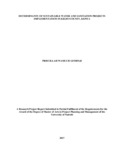| dc.contributor.author | Githinji, Priscillah W | |
| dc.date.accessioned | 2018-01-03T06:35:45Z | |
| dc.date.available | 2018-01-03T06:35:45Z | |
| dc.date.issued | 2017 | |
| dc.identifier.uri | http://hdl.handle.net/11295/102156 | |
| dc.description.abstract | Sustainable water use and management is a step that must be chore in the life of human beings for survival. As a natural resource, water defines to a very huge extent and shape human beings‟ livelihood. In an ambience of acute water shortage or inadequate water supply, no significant human progression is manifestly expressed insofar as sustainable socio – economic growth is concerned. Therefore, there is a need to study water and sanitation projects suitability due to their importance. The purpose of the study was to examine the determinants of sustainable water and sanitation projects implementation in Kilifi County, Kenya. This study was guided by the following objectives: to examine the extent to which structural facilities influence the implementation of sustainable water and sanitation projects in Kilifi County; to examine the extent to which institutional arrangements influence the implementation of sustainable water and sanitation projects in Kilifi County; to examine the extent to which community participation influences the implementation of sustainable water and sanitation projects in Kilifi County; to examine the extent to which competitive policies and strategies influence the implementation of sustainable water and sanitation projects in Kilifi County; and to examine the extent to which political will influence the implementation of sustainable water and sanitation projects in Kilifi County, Kenya. This study adopted a descriptive research design. Target population was 809 respondents constituting the household Heads, MAWASCO employees and NGOs employees. Sample population was 265 and the stratified sampling was applied so that each respondent from each category. The questionnaire was used for data collection. The research instrument was pilot tested in the neighbouring Mombasa County. In the study, 265 questionnaires were allocated to respondents in various strata. Out of the issued 265 questionnaires, only 123 were well filled and therefore made sense for the study. Male respondents, 90 (73.17%), registered the most as compared to their female counterparts, 33 (26.83%). Results indicated that, majority of the respondents (100 who equated to 81.30%) supported the idea that structural facilities have an influence on the implementation of sustainable water and sanitation projects. Also, majority of the respondents (110 who represented 90%) supported the idea that institutional arrangements influence the implementation of sustainable water and sanitation projects. A majority of the respondents indicated that the community performs a major role in the implementation, provision and success of the pro poor water and sanitation services by doing various activities. Moreover, majority of the respondents supported the idea (64 respondents who represented 52%) that competitive policies influence the implementation of water and sanitation projects in the informal settlements. Finally, majority of the respondents (116 who made 95%) supported the idea that politicians have a very magnificent influence of pro poor water and sanitation projects implementation. The researcher suggested that a similar study can be done in any of the 47 counties in the country. | en_US |
| dc.language.iso | en | en_US |
| dc.publisher | University of Nairobi | en_US |
| dc.rights | Attribution-NonCommercial-NoDerivs 3.0 United States | * |
| dc.rights.uri | http://creativecommons.org/licenses/by-nc-nd/3.0/us/ | * |
| dc.subject | Water and Sanitation Projects, Implementation, Sustainable, Structural Facilities, Institutional Arrangements, Community Participation, Competitive Policies and Strategies, and Political. | en_US |
| dc.title | Determinants of Sustainable Water and Sanitation Projects Implementation in Kilifi County, Kenya | en_US |
| dc.type | Thesis | en_US |



